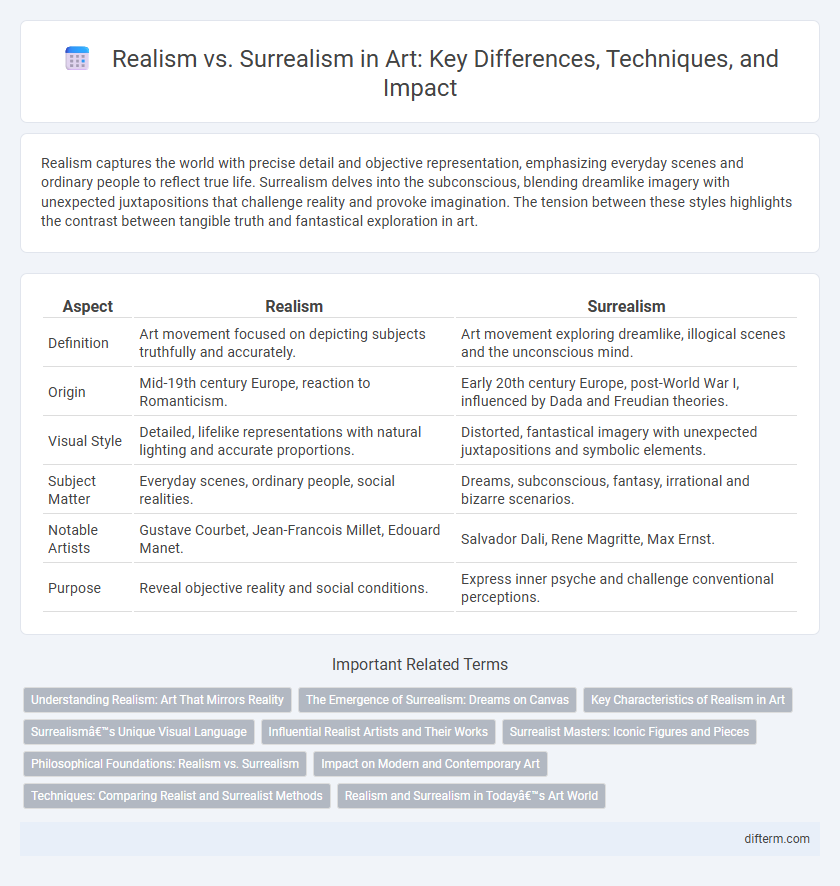Realism captures the world with precise detail and objective representation, emphasizing everyday scenes and ordinary people to reflect true life. Surrealism delves into the subconscious, blending dreamlike imagery with unexpected juxtapositions that challenge reality and provoke imagination. The tension between these styles highlights the contrast between tangible truth and fantastical exploration in art.
Table of Comparison
| Aspect | Realism | Surrealism |
|---|---|---|
| Definition | Art movement focused on depicting subjects truthfully and accurately. | Art movement exploring dreamlike, illogical scenes and the unconscious mind. |
| Origin | Mid-19th century Europe, reaction to Romanticism. | Early 20th century Europe, post-World War I, influenced by Dada and Freudian theories. |
| Visual Style | Detailed, lifelike representations with natural lighting and accurate proportions. | Distorted, fantastical imagery with unexpected juxtapositions and symbolic elements. |
| Subject Matter | Everyday scenes, ordinary people, social realities. | Dreams, subconscious, fantasy, irrational and bizarre scenarios. |
| Notable Artists | Gustave Courbet, Jean-Francois Millet, Edouard Manet. | Salvador Dali, Rene Magritte, Max Ernst. |
| Purpose | Reveal objective reality and social conditions. | Express inner psyche and challenge conventional perceptions. |
Understanding Realism: Art That Mirrors Reality
Realism in art emphasizes accurate and detailed depiction of everyday life, capturing scenes with true-to-life colors, lighting, and proportions. This movement prioritizes authenticity and objective representation, often highlighting social realities and ordinary people without idealization. By mirroring reality, Realism provides a direct visual commentary on contemporary society, contrasting sharply with the imaginative and dreamlike qualities of Surrealism.
The Emergence of Surrealism: Dreams on Canvas
Surrealism emerged in the early 20th century as a radical departure from Realism, emphasizing the exploration of the unconscious mind through dreamlike and fantastical imagery. Artists like Salvador Dali and Rene Magritte used techniques such as automatism and juxtaposition to create surreal landscapes that challenge perceptions of reality. This movement redefined artistic expression by blending reality with imagination, pushing the boundaries of traditional representation on canvas.
Key Characteristics of Realism in Art
Realism in art is defined by its detailed, unembellished depiction of everyday life and ordinary people, emphasizing accurate, naturalistic representation without idealization. Key characteristics include a focus on social issues, use of muted color palettes, and an emphasis on light and shadow to create depth and texture. Realist artists prioritize authenticity and often portray subjects in their natural environments to reflect contemporary reality.
Surrealism’s Unique Visual Language
Surrealism's unique visual language harnesses dreamlike imagery, unexpected juxtapositions, and symbolic elements to explore the subconscious mind beyond realistic representation. Unlike Realism's focus on accurate depictions of everyday life, Surrealist artists manipulate form and perspective to challenge perceptions and evoke emotional or psychological responses. This movement integrates automatism and bizarre scenes, creating a distinctive artistic vocabulary that transcends traditional visual norms.
Influential Realist Artists and Their Works
Gustave Courbet, a pioneering figure in Realism, challenged traditional artistic norms with works like "The Stone Breakers," capturing the raw, unidealized lives of laborers. Jean-Francois Millet's paintings, including "The Gleaners," emphasized rural poverty and peasant life through detailed, naturalistic depictions. Edouard Manet bridged Realism and Impressionism, his controversial pieces such as "Olympia" highlighted modernity and social realities with stark, straightforward representation.
Surrealist Masters: Iconic Figures and Pieces
Surrealism, championed by masters such as Salvador Dali and Rene Magritte, revolutionized art with dreamlike imagery and illogical scenes that challenge perception and reality. Iconic works like Dali's "The Persistence of Memory" and Magritte's "The Son of Man" exemplify the movement's emphasis on the unconscious mind and symbolic content. These pieces continue to influence contemporary art by blending fantastical elements with meticulous detail.
Philosophical Foundations: Realism vs. Surrealism
Realism emphasizes an objective representation of everyday life, grounded in empirical observation and a commitment to portraying the world as it appears, reflecting philosophical principles of truth and accuracy. Surrealism, rooted in the exploration of the unconscious and dream states, advocates for the liberation of the mind from rational constraints, drawing from Freudian psychoanalysis and existentialist ideas about reality beyond the visible. The philosophical foundations of Realism and Surrealism ultimately contrast empirical certainty with intuitive exploration, shaping distinct approaches to artistic expression and the representation of human experience.
Impact on Modern and Contemporary Art
Realism's emphasis on accurate depictions of everyday life introduced a foundation for objective observation in modern art, influencing movements such as social realism and abstract expressionism. Surrealism's exploration of the unconscious mind and dream imagery expanded artistic boundaries by encouraging experimentation with irrational and fantastical themes, profoundly impacting contemporary art forms like pop surrealism and conceptual art. Both movements challenged traditional aesthetics, reshaping creative approaches and inspiring diverse visual narratives in the 20th and 21st centuries.
Techniques: Comparing Realist and Surrealist Methods
Realist artists emphasize precise, detailed techniques that replicate scenes as accurately as possible, often using fine brushwork and careful shading to create lifelike images. Surrealist painters employ unexpected juxtapositions, dream-like imagery, and automatic drawing methods to evoke the unconscious mind. While realism relies on observation and representation, surrealism prioritizes imagination and symbolic meaning through experimental approaches.
Realism and Surrealism in Today’s Art World
Realism in today's art world emphasizes accurate, detailed depictions of everyday life, often highlighting social issues and human experiences with striking clarity. Surrealism continues to challenge perceptions by blending dreamlike imagery with unexpected juxtapositions, encouraging viewers to explore the subconscious mind and abstract concepts. Contemporary artists frequently merge Realist techniques with Surrealist themes, creating hybrid works that reflect both tangible reality and imaginative realms.
Realism vs Surrealism Infographic

 difterm.com
difterm.com